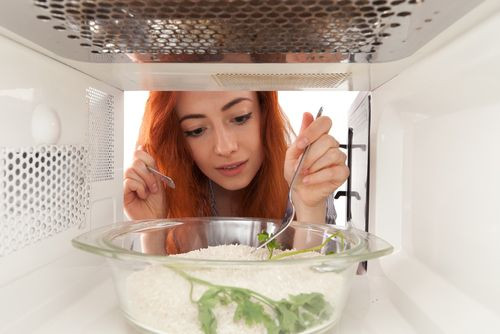6 Healthy Foods That Lose Their Nutritional Value In The Microwave: To Nuke Or Not To Nuke?

As the phrase “you are what you eat” has proven to be true, the same holds for “you are how you cook.” It is not contested the microwave is one of the most used and touted modern conveniences that allows us to be “culinary chef” — a step up from our Easy-Bake Oven days — in just seconds. While it seems the microwave can do anything, from baking a potato in minutes to single serving cakes in coffee mugs, there are some foods that actually lose their nutritional value when they’re nuked.
With over 90 percent of American homes owning a microwave, according to the U.S. Department of Agriculture, there is much controversy surrounding the ho-hum appliance because of its electromagnetic radiation. These short radio waves are responsible for causing the water molecules in food to vibrate, which then produces the heat that cooks the food. Although the question of whether microwaves are bad for food really boils down to how it’s cooked. Not all foods are cooked equal in the microwave, so avoid these six foods to protect your health:
1. Asparagus
Cooking fresh asparagus spears in the microwave may seem like a quick fix to adorning your dinner plate, and an even faster way of losing your meal’s nutrients. The spring vegetable provides a wide variety of antioxidant nutrients, including vitamin C, which is stripped away when microwaved. A 1999 study published in the journal Acta Agroculturae Scandinavica B found microwaving asparagus caused a reduction in vitamins, specifically vitamin C. Since vitamin C, along with vitamin B, are water-soluble vitamins, they are less stable, and can be destroyed by water, heat, air, and light.
2. Breast Milk
Breast milk is one of the best ways a mother can deliver nutrients and bacteria-fighting agents to her newborn. Squeezing the breast milk into a baby bottle to reheat for later could diminish these nutrients. A 1992 study published in the journal Pediatrics found breast milk heated on high heat showed greater E. coli growth that was 18 times higher than the milk heated without a microwave. The breast milk samples at lower temperatures showed a decrease in isozyme activity as well as led to the growth of harmful bacteria for babies.
3. Broccoli
This vegetable is one of the most common microwaved food items in American households. However, cooking broccoli in the microwave with water can actually cause it to lose up to 97 percent of its antioxidants, according to a 2003 study published in the Journal of the science of Food and Agriculture. Stovetop cooking only result in an 11 percent loss. While critics say that more water was used than necessary for a microwave, an important factor when cooking vegetables is less water is more.
4. Dried Hot Peppers
It is dangerous to microwave dried hot peppers due to the capsaicin chemical that is volatile and can easily catch fire. The chemical released from these peppers when microwaved can sting your eyes and burn your throat. Peppers in general should not be microwaved because they contain a higher amount of minerals such as iron, magnesium, and selenium, than other food items. The minerals act like tiny pieces of metal, and therefore create arcing effects in a microwave. Their nutritional value will also decrease when they’re nuked.
5. Frozen Fruit
Buying frozen food and heating it in the microwave can cut down our cooking time by several minutes. However, when it comes to frozen fruits, its nutrients are lost the moment they are picked and packaged. A 2010 study — a replication of earlier Soviet studies — published in the journal of Bioelectromagnetics found defrosting frozen fruit in the microwave could actually turn beneficial glucoside and galactaside into carcinogenic substances. It’s best to thaw frozen fruit in the fridge or on a counter top in the kitchen.
6. Garlic
Choosing to microwave rather than stovetop cook this seasoning could reduce its health benefits. A 2001 study published in the Journal of Nutrition found microwave heating garlic for as little as 60 seconds, or 45 minutes of oven heating, was enough to inactivate allinase — the active ingredient in garlic — against cancer in rats. This finding suggests heating destroyed garlic’s active allyl sulfur compound formation, which may be related to its anticancer properties.
As a rule of thumb, it’s best to stovetop and oven-cook foods when feasible, and use the microwave when necessary.



























